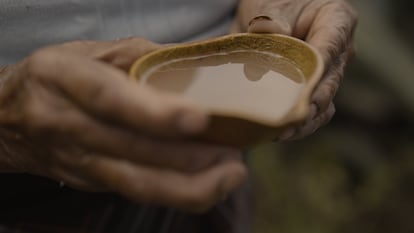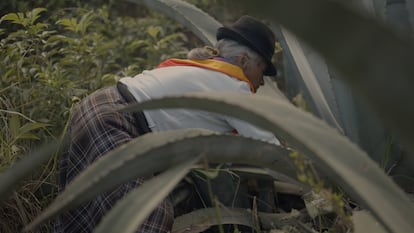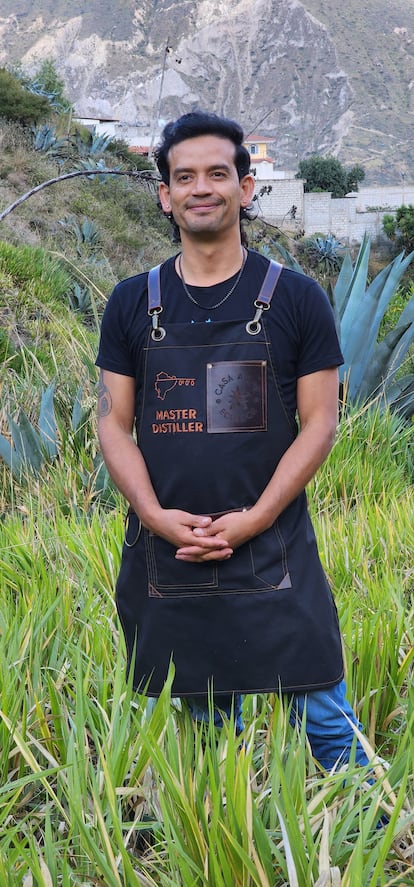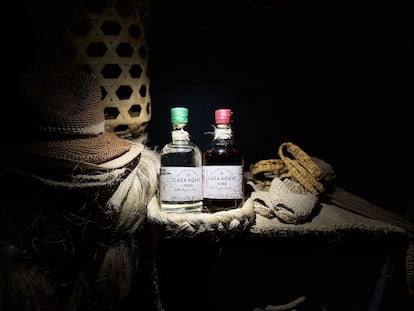Miske, the ancient Indigenous drink that is being revived around the world
It’s the only Ecuadorian drink that bears a designation of national origin. The production of this beverage has given rise to a social project that centers women

Of Indigenous origin, chawarmishki — or agave sap, when translated from Quechua — is one of the oldest drinks in America. However, it’s often been the most denigrated beverage, for having been considered the drink of the so-called “Indians,” or the Indigenous people of the Andes. Produced mostly by women, its distillate — miske — is the only Ecuadorian drink that bears a designation of national origin.
In the so-called middle of the world — specifically, at latitude 00º 00′ 00″ — there’s a small distillery where the sap of the American agave cactus, or blue agave, is made into an alcoholic drink. Located on the land that separates the two hemispheres, Casa Agave was born as a project to revitalize an ancestral drink with an ancient tradition. Originating from the middle of the Andes, miske has been part of the local culture since the creation of the first native communities of Quito.
Prehistoric cactus

“This cactus is a plant dinosaur — it’s a prehistoric plant. Agave sap has been a wild food and drink for the inhabitants of the Andes for thousands of years. [This is also the case in] Mexico, where they have a really strong ancestral culture of agave. The difference is that they call it ‘pulque’ there. In Ecuador, we call it miske,” explains Diego Mora, the owner of Casa Agave.
Denigrated for being the water of the Indians — or “the water of the poor” — its importance within Ecuadorian culture began to be lost over time. Little by little, the job of the mishquero or mishquera — the person who has all the necessary knowledge for the extraction of chawarmishki — began to disappear, until Don Virgilio Collahuazo was the last remaining mishquero in Ecuador.
Diego Mora learned everything from Don Virgilio when, 22 years ago, he arrived in the valleys of Quito to recover and honor this ancestral Andean heritage. This is how Casa Agave was born: a project that not only focuses on rescuing this Ecuadorian cultural and gastronomic tradition, but also strives to recover a very special plant that’s typical of the area’s nine communities.
“Native people have a special connection with their land and with products like agave, a plant that’s considered a God on whose leaves they write wishes,” Mora explains. There are more than 300 varieties of agave spread across Central and South America. It’s possible to extract sap from certain species and make distillates, while the pulp of other types can be used in cooking. Certain varieties are dedicated solely and exclusively to the production of crafts, papers and textiles, via the use of their fibers.
The roots of agave have a substance similar to saponin, which is used as soap. Household objects — and even entire houses — can be built with its wood. However, it’s in Ecuador where, according to Mora, it has the best quality. Thanks to its location in the middle of the world, “the plants have perpendicular light 365 days a year, which translates into sugars that help in their distillation.”
The water of the poor

Its uniqueness is that, in order to collect the sap — which can be drunk without any type of processing — the plant must be at least 10-years-old. “Only the interior is cut and the liquid inside is collected. This action is carried out two to three times a day for four months, from which around ten liters [of sap] are extracted daily,” the producer explains. “Chawarmishki
is a nutritious drink that was formerly used to hydrate, to treat stomach problems and to make children grow up healthy and strong.” Nine mishqueras from different Indigenous communities — all over the age of 60 — are now responsible for extracting the sap.
“Casa Agave is also a social, environmental and cultural project. The women of these communities are the heads of their households. They’re managing to support their families for the first time in history. It’s a silent feminine revolution and it’s being carried out by creating one of the most sustainable products in Ecuador, since the agave grows in desert areas and on stony soils where it doesn’t need anything,” Mora emphasizes.
From reforestation to the designation of national origin

In addition to selling chawarmishki, Casa Agave also produces miske, its distillate. This is the only beverage in Ecuador that has received a designation of national origin. On this hacienda, 3,000 liters of agave sap are collected each month, which, in turn, are converted into 250 bottles of miske. In 2021 and 2022, the drink was awarded a total of three gold medals, one silver and one bronze at the World Spirits Competition. These awards are just a sample of the work behind this social project, which values one of the oldest heritages of the equatorial inter-Andean valleys: the agave culture.
Making miske isn’t the only thing they do at Casa Agave. Their project also includes a reforestation plan for different types of agave cacti over a 20-year-long period. Everyone who tours the distillery is invited to plant a small agave plant in the nursery. This involves visitors in the recovery of an ancestral plant and an ancient drink.
Sign up for our weekly newsletter to get more English-language news coverage from EL PAÍS USA Edition
Tu suscripción se está usando en otro dispositivo
¿Quieres añadir otro usuario a tu suscripción?
Si continúas leyendo en este dispositivo, no se podrá leer en el otro.
FlechaTu suscripción se está usando en otro dispositivo y solo puedes acceder a EL PAÍS desde un dispositivo a la vez.
Si quieres compartir tu cuenta, cambia tu suscripción a la modalidad Premium, así podrás añadir otro usuario. Cada uno accederá con su propia cuenta de email, lo que os permitirá personalizar vuestra experiencia en EL PAÍS.
¿Tienes una suscripción de empresa? Accede aquí para contratar más cuentas.
En el caso de no saber quién está usando tu cuenta, te recomendamos cambiar tu contraseña aquí.
Si decides continuar compartiendo tu cuenta, este mensaje se mostrará en tu dispositivo y en el de la otra persona que está usando tu cuenta de forma indefinida, afectando a tu experiencia de lectura. Puedes consultar aquí los términos y condiciones de la suscripción digital.
More information
Archived In
Últimas noticias
Most viewed
- Reinhard Genzel, Nobel laureate in physics: ‘One-minute videos will never give you the truth’
- Oona Chaplin: ‘I told James Cameron that I was living in a treehouse and starting a permaculture project with a friend’
- Pablo Escobar’s hippos: A serious environmental problem, 40 years on
- Charles Dubouloz, mountaineering star, retires at 36 with a farewell tour inspired by Walter Bonatti
- Why we lost the habit of sleeping in two segments and how that changed our sense of time










































